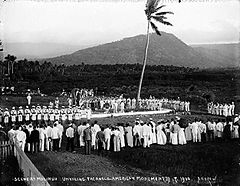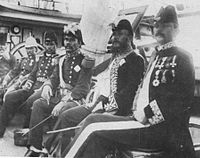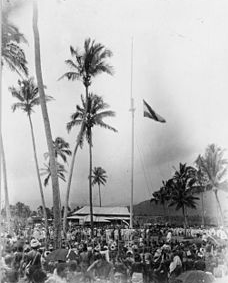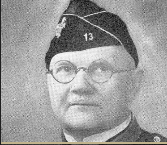HAVE A RESPECTFUL MEMORIAL DAY, EVERYONE! I like to honor American veterans from some of our nation’s overlooked military actions since their service often seems forgotten. This year it’s the Second Samoan Civil War (1898-1899).
 THE CONFLICT – On August 22nd, 1898 Malietoa Laupepa passed away. He had been the ruling King of Samoa by agreements among the German Empire, Great Britain and the United States. With his passing, the U.S. and Great Britain supported the ascension of his son Malietoa Tanumafili to the throne. The Germans supported Mata’afa Iosefo, a former rival of the late king who returned from exile.
THE CONFLICT – On August 22nd, 1898 Malietoa Laupepa passed away. He had been the ruling King of Samoa by agreements among the German Empire, Great Britain and the United States. With his passing, the U.S. and Great Britain supported the ascension of his son Malietoa Tanumafili to the throne. The Germans supported Mata’afa Iosefo, a former rival of the late king who returned from exile.
Neither side would yield, and the three nations began reinforcing their military positions in the Samoan Islands to fight the imminent war. By January of 1899 Malietoa Tanumafili had been driven into exile by the Germans and their Samoan allies. The German-Mata’afan forces began forcibly removing Americans and Europeans from their homes.
On March 14th the first major battle of the war took place as the Germans and their Samoan allies besieged the American and British forces at the city of Apia. The American and British navies took up positions and began a weeks-long bombardment of German-Mata’afan forces. The combined Anglo-American naval and marine corps forces were under the overall command of American Rear Admiral Albert Kautz.
 Just past Midnight on March 15th the German-Samoan forces attacked the main Allied positions at Apia as well as the American and British consulates in nearby locations. The German side was repulsed at all locations and forced to retreat.
Just past Midnight on March 15th the German-Samoan forces attacked the main Allied positions at Apia as well as the American and British consulates in nearby locations. The German side was repulsed at all locations and forced to retreat.
By 5PM fighting had spread to Vaiusu, Mulinuu and Vaimoso. Siege operations and daily fighting continued until March 30th, when Americans, Brits and their Samoan allies charged the German-Samoan forces. The Allies won and the German forces in the war retreated toward their main stronghold in Vailele.
Beginning on March 31st the U.S. and their allies quickly followed up their success, moving land forces toward Vailele. Two more battles were fought which reduced two towns on the German side to ruins as the Allies won both, forcing the German forces to keep retreating.
 On April 1st a joint amphibious operation between the U.S. and Great Britain landed at Vailele but was defeated and driven off by the German side in a huge victory. RADM Kautz and British Royal Navy Captain Leslie Creery Stuart attributed the defeat to the naval and marine corps losses from typhoon damage to ships during the two weeks of the Siege of Apia.
On April 1st a joint amphibious operation between the U.S. and Great Britain landed at Vailele but was defeated and driven off by the German side in a huge victory. RADM Kautz and British Royal Navy Captain Leslie Creery Stuart attributed the defeat to the naval and marine corps losses from typhoon damage to ships during the two weeks of the Siege of Apia.
After that First Battle of Vailele, both sides settled in for a longer war. The Allies sent frequent expeditions into the jungle in search of concentrations of German-Mata’afan troops. A few battles took place at Falefa, the ancient Samoan capital and a German stronghold.
On April 13th the Allies took more ground just south of Vailele, defeating the German forces who tried to dislodge them. That victory was followed by two losses as the Allies failed to seize the two forts guarding Vailele.
The bombardment of other German-Mata’afan towns resumed, with the British ships even using experimental Lyddite Shells on the town of Vailima. More fighting took place at Papase’ea, Utumau’u and Fagaloa.
 On April 25th the Second Battle of Apia took place. The German side attacked Allied forces at Apia once more and were repulsed with heavy casualties.
On April 25th the Second Battle of Apia took place. The German side attacked Allied forces at Apia once more and were repulsed with heavy casualties.
Throughout June and early July, Allied bombardment of German-Mata’afan towns continued, but international pressure eventually prompted the U.S. and Great Britain to back off from that strategy.
Diplomatic efforts continued, and by November 9th a Tripartite agreement was made among the various nations and signed on December 2nd. Great Britain withdrew all claims to the Samoan Islands in exchange for concessions from Germany in the Solomon Islands. Samoa was divided into American Samoa and German Samoa, with American Samoa still a territory of the U.S. to this day.
MEDAL OF HONOR WINNERS:
 FREDERICK T. FISHER
FREDERICK T. FISHER
Branch of Service: Navy
Rank: Gunner’s Mate 1st Class
Citation: “… for extraordinary heroism in action on board the U.S.S. Philadelphia, Samoa, 1 April 1899. Serving in the presence of the enemy on this date, Gunner’s Mate First Class Fisher distinguished himself by his conduct.”

BRUNO A. FORSTERER
Branch of Service: Marine Corps
Rank: Sergeant
Citation: “For distinguished conduct in the presence of the enemy near Tagall in Samoa, 1 April 1899.” NOTE: Sadly, the citations for these awardees from the Samoan Campaign lack the detailed descriptions of their heroics that readers may remember from all the other Medal of Honor blog posts I’ve made.
 HENRY L. HULBERT
HENRY L. HULBERT
Branch of Service: Marine Corps
Rank: Private
Citation: “For distinguished conduct in the presence of the enemy while serving with the Marine Guard, U.S.S. Philadelphia in action at Samoa, 1 April 1899.” NOTE: Hulbert eventually rose to the rank of Lieutenant and was killed in action during World War One.
 MICHAEL J. MCNALLY
MICHAEL J. MCNALLY
Branch of Service: Marine Corps
Rank: Sergeant
Citation: “For distinguished conduct in the presence of the enemy at Samoa, 1 April 1899.”
FOR MY LOOK AT AMERICAN FORCES SERVING IN RUSSIA FROM 1918-1920 CLICK HERE.
FOR MY LOOK AT MEDAL OF HONOR RECIPIENTS FROM THE BOXER REBELLION EXPEDITION CLICK HERE.
FOR MY LOOK AT MEDAL OF HONOR RECIPIENTS FROM THE PHILIPPINE WAR (1899-1902) CLICK HERE and HERE and HERE.
FOR ELEVEN MEDAL OF HONOR RECIPIENTS FROM WORLD WAR ONE CLICK HERE.
FOR MY TOP FOUR NEGLECTED WARS IN AMERICAN HISTORY CLICK HERE.

Though I don’t like war personally I am a laughing and peaceful person but every country needs soldiers and they all are great soldier and captain 💪 well shared.
Thank you! On Memorial Day I like to post reminders about those who served in these forgotten wars.
🫡🫡🫡
😀
🫡🫡🫡
😀 😀 😀
Well done, and a most interesting and informative read.
Thank you very much, sir and thank you again for your service.
I never know how to respond to that. I think of buds not here for their sacrifices and “unthankable.” That’s what it’s all about. Young men and women don’t constantly think of what they do, they just do it. I did. Many did. It was just something we felt, never thought about. That way more so in the past it seems, less so now. Perhaps I’m wrong.
Suppose the proper response is. “You’re welcome.” Seems rather empty when those I need to thank, can’t hear me, or from Korea, WWI, WWII, Eastern Europe, and Middle East campaigns are not treated respectfully or fully according to contracts between them and the government of this nation. [Notice absence of the word “great” from the phrase “great nation.”]
Very moving reply, Espie, and I appreciate the sentiments behind it. In my view, whatever reply that people who served want to offer back is just fine. Especially given the less-than-great state of the country, like you mentioned. These posts I do around Memorial Day and Veterans Day are my meager contribution to keeping alive the memory of those who didn’t come back.
well remembered. Thank you.
Thank you for the kind words!
Pingback: VIDEO President Trump Comforts Gold Star Families at NASCAR Race – Biden ignored Gold Star Family from Surrender – NarrowPathMinistries
Logged, thanks for the link!